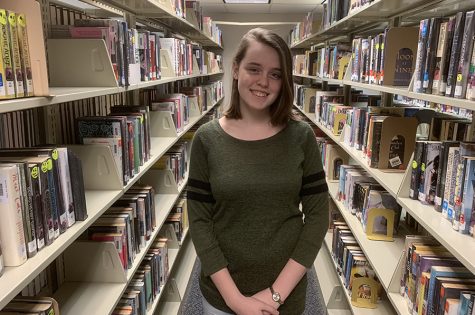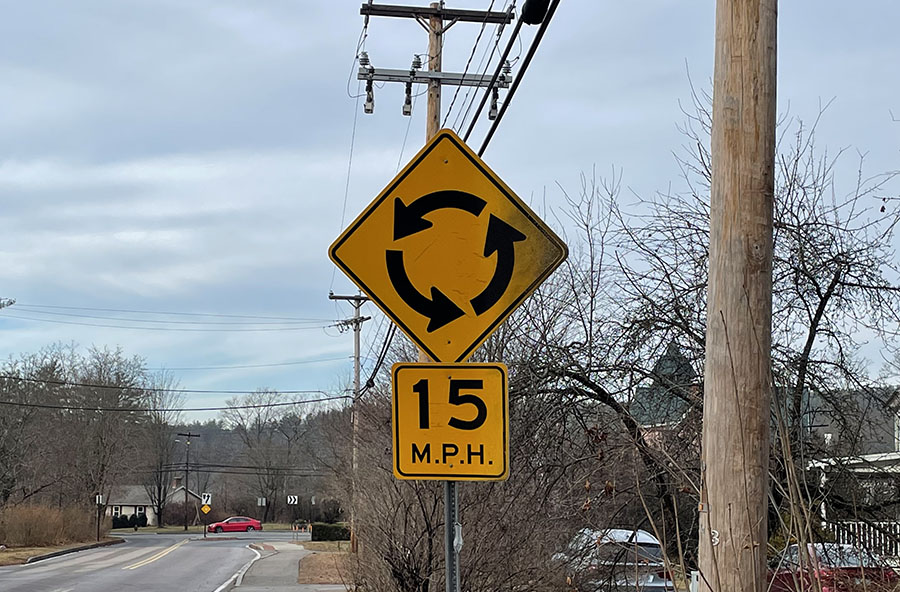A Conversation About Traffic Circles
Most of the staff and students at Goffstown High School have to enter the traffic circle on Mast and Wallace Road. After interviewing a student and a teacher here at GHS, I found out that they are in agreement with the Goffstown Select Board Committee: the main problem with the traffic circle is its size. In 2020 the Goffstown Select Board Committee had multiple meetings discussing two issues with the traffic circle there. The first meeting, in April, was to discuss and propose an alternative traffic circle to allow commercial trucks to pass through the rotary without hitting the curb and the island in the middle. The committee solved this problem by posting a sign that tells the truck drivers to not use the traffic circle as a means of making a U-turn. This is because the traffic circle there “is one of the smallest traffic circles in New Hampshire,” and large trucks cannot fit through it. (1) Additionally, people have complained that the busses that go through the traffic circle have a hard time getting around it.
The proposal to make it bigger, although not approved, did result in some surprising concerns about how the traffic flows through the rotary. Later this year, the Goffstown Select Board had a public hearing discussing the proposal of adding a stop sign right before the traffic circle on Wallace road. Although the Board was only allowing callers to offer their thoughts, about twenty different callers responded to the proposal. All of the callers opposed the idea of putting a stop sign right before the rotary because “it totally defeats the purpose of the traffic circle.” (2) Many people interviewed added that before the traffic circle there were stop signs and they seemed to work better. The original reason the traffic circle was put into place, back in 2012, was to replace the three original stop signs and to clear the traffic congestion.
As more callers voiced their opinion, it became very clear that a stop sign was not what the traffic circle needed to slow cars down. Instead, multiple callers voiced that there needed to be a “driver education” on how traffic circles worked. (2, 3) For clarification on how to use a roundabout, the Washington State of Department Transportation clearly says that “in a modern roundabout… drivers yield at entry to traffic already in the roundabout, then proceed into the intersection and exit at their desired street.” (4) This indicates that some people don’t understand what the term yield means, or completely ignore it. “Yield means to let other road users go first.” (5)
After asking how some people used the traffic circle, I learned that they didn’t know exactly what the speed limit was but they guessed around ten to twenty miles per hour. “Everybody has to go super slow because of its size,” one person said. While the Select Board members came to the conclusion that a stop sign was not the right sign to be “used for speed control” in the rotary, they didn’t find another way to control the speed of the traffic. (2) Instead, they decided to let the traffic circle be without a stop sign. When I asked people what they think should’ve been done, they questioned why the traffic circle was put in back in 2012 because the stop sign seems to work the best.
Works Cited:
- Goffstown Television. “LIVE – Select Board Meeting 4/27/2020.” Youtube, Goffstown TV, 27 Apr. 2020, www.youtube.com/watch?v=spqXuDKFEGw.
- Goffstown Television. “LIVE – Select Board Meeting 9/14/2020.” Youtube, Goffstown TV, 14 Sept. 2020, www.youtu.be/B6Y80BR6rD8.
- Goffstown Television. “Goffstown Select Board September 28/2020.” Youtube, Goffstown TV, 28 Sept. 2020, https://www.youtube.com/watch?v=PUDmTlhbn-s
- “What Is a Roundabout?” WSDOT, 9 Oct. 2017, wsdot.wa.gov/Safety/roundabouts/BasicFacts.htm.
- DriversEd.com. “Yield.” Yield – DriversEd.com, 2020, driversed.com/resources/terms/yield.aspx.
Other Links:
- Proposed Plan in April 2020: https://www.goffstown.com/images/documents/public-notices/2020/04-27-2020-Wallace-Rd-Roundabout-Presentation.pdf

Kara is a senior at Goffstown High School. She enjoys creating pieces of art and performing in GHS theater productions. She is planning to be a high school...








